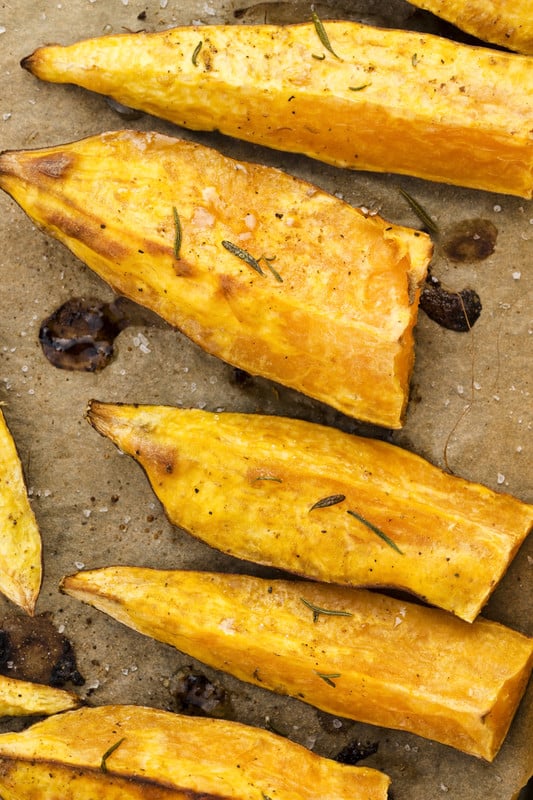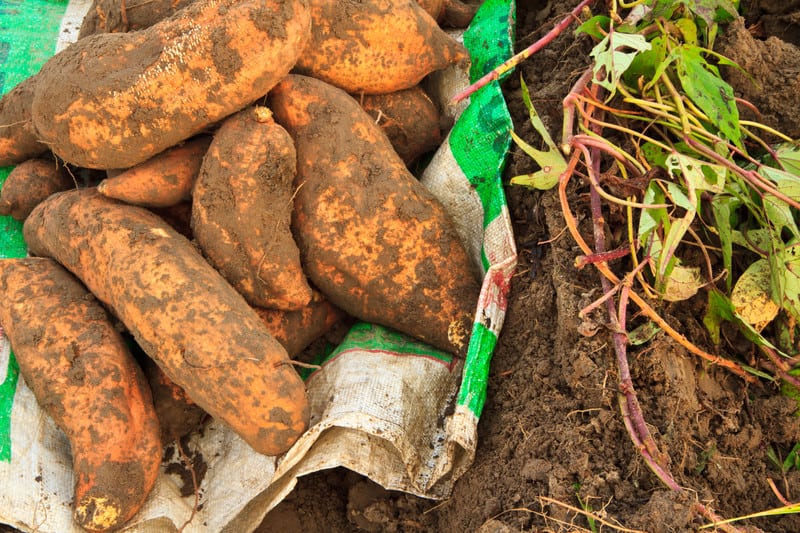Seven Ways to Cook and Serve Sweet Potatoes
Sweet potatoes can be cooked and prepared in just about every way a potato can.
Favorite sweet potato recipe
Two types of sweet potato
- There are two main types of sweet potato (although there are more than 400 varieties): one has orange flesh and becomes soft and moist when cooked, and the other has white flesh and becomes relatively dry and crumbly when cooked.
- The sweet potato with white-colored flesh is sometimes called white sweet potato but also batata, batata dulce, camote, and Cuban sweet potato.
- The sweet potato with orange-colored flesh is called sweet potato and also yam. The orange-fleshed sweet potato was dubbed “yam” in the 1930s when growers in the American state of Louisiana wanted to distinguish their orange-fleshed sweet potatoes from the white-fleshed sweet potatoes grown in New Jersey, Maryland, and Virginia. Calling a yellow-fleshed sweet potato a yam was simply a marketing decision.
- Sweet potatoes—white-fleshed or orange-fleshed—can be prepared just like a potato: baked, simmered, steamed, fried, and roasted.

How to choose a sweet potato
- Choose sweet potatoes with smooth, firm skins and no blemishes or bruises. Small and medium-sized sweet potatoes taste better than large ones which can be fibrous. Avoid sweet potatoes that are withered, wrinkled, sticky, damp, or sprouting.
- Dark-orange-skinned sweet potatoes have orange flesh (erroneously called yams) that can be baked, boiled, roasted, sautéed, or fried as chips. This sweet potato will cook up moist and sweet.
- White-skinned sweet potatoes are thin-skinned and have pale yellow flesh. They will become dry and crumbly after cooking and will not taste sweet. This sweet potato is similar to a white baking potato.
How to store sweet potatoes
- Sweet potatoes will keep for up to 2 weeks in a cool, dry, dark, and well-ventilated place. But they are best used within a week of purchase.
- Sweet potatoes should not be refrigerated.
How to prepare sweet potatoes for cooking
- Cook a sweet potato just as you would a regular potato—roast, boil, mash, or bake. (White varieties can be substituted for regular potatoes in most recipes.)

How to bake a sweet potato
- Preheat the oven to at least 400 degrees F.
- Prick the potato skin in several spots with a fork; this will allow steam to escape.
- Lightly brush the tuber with olive oil, salt, and pepper.
- Place the tuber on a foil-lined baking sheet or shallow pan.
- Bake until the flesh is tender and the skin crisp, 45 to 60 minutes depending on the size of the tuber.
- Serve with a pat of butter, salt, and ground black pepper or butter and a sprinkle of brown sugar or serve with feta cheese, crumbled bacon, sour cream, and fresh chives.
How to roast a sweet potato
- Large tubers can be roasted with the skin on or peeled. Large tubers can be cut into thick wedges.
- Precook cut tubers in a microwave until soft but still firm, about 4 minutes. Or boil in salted water until tender, about 10 minutes.
- Preheat the oven to 450 degrees F.
- Spread the tubers on a pan or baking sheet. Drizzle the tubers with olive oil or fat and toss well. The tubers should be evenly coated and the pan should have light, even oil across the surface.
- Season with salt, dry herbs, or spices.
- Roast 20 to 30 minutes, until bottoms are browned and a spatula slides under them smoothly.
- Turn and keep roasting until done about 20 to 30 minutes.
How to make mashed sweet potatoes
- Peel two large sweet potatoes per person and cut them into large chunks.
- Bring a large pot of water to a boil; add a tablespoon of salt for each gallon of water.
- Boil the potatoes until tender all the way through; begin testing for tenderness after 10 minutes.
- While the potatoes are boiling heat added flavorings such as milk, cream, butter, buttermilk or stock
- Remove tender potatoes with a slotted spoon and let them drain in a colander. Reserve a cup of cooking water.
- Return potatoes to the pot. Place over low heat and shake until most of the steam has dissipated.
- Add hot or warm flavorings, mash, and taste. Add salt to taste. Repeat until mashed and seasoned to your liking. Adjust the texture with cooking water.
- Serve immediately or cover tightly in a ceramic bowl and set aside for up to 30 minutes. To reheat cold mashed potatoes set the bowl inside a pot partially filled with water and simmer until the potatoes are warm again.
How to make sweet potato fries
- Peel large sweet potatoes and cut lengthwise into slices, ⅜ to ½ inch thick, keeping the slices together.
- Quarter turn the slices and cut slices into strips. Or cut potatoes into round slices, medium-size chunks or wedges.
- Soak the cut potatoes in cold water at least 30 minutes or overnight. Drain potatoes and pat dry.
- Place the potatoes in a deep heavy pot and pour in vegetable oil to cover, plus an inch or two more.
- Heat the oil and potatoes to a simmer and cook slowly until very soft, for about 30 minutes. Stir occasionally to prevent sticking.
- Raise the heat to medium. Let the soft potatoes fry in bubbling oil until golden and crisp, another 10 to 15 minutes
- Remove the potatoes with a slotted spoon and place in a paper towel-lined bowl. Shake to drain.
- Remove the paper towels. Add salt, and shake again. Serve hot.
How to boil sweet potatoes
- Boil sweet potatoes with the skin intact if the potato is small. Peel and quarter larger potatoes.
- Boil in well-salted water (salted water will make the potato tastier) until tender, that is until a sharp knife can pierce the potato with little resistance.
- Drain the water and set the potatoes in a colander to dry. Potatoes will continue to cook for a bit after they are out of the boiling water.
- Serve hot with melted butter and minced herbs, or drizzled with olive oil and lemon zest.
- Boiled potatoes can sit at room temperature for nearly an hour before the flavor and texture start to deteriorate.
- You can mash boiled sweet potatoes and potatoes together for extra smoothness—add grated ginger and a little ground cardamom.
- Sweet potatoes can be peeled before or after they are cooked.
How to make sweet potato soup
- Peel the sweet potatoes. Quarter the tubers if large.
- Boil or microwave the tubers until tender.
- Puree the sweet potatoes in a blender with chicken or vegetable stock and flavor with onions, carrots, apples, or fresh ginger.
- Simmer or microwave the purees and serve hot.
How to make sweet potato pie
- You can make a sweet potato pie by baking or steaming the orange-fleshed sweet potato, then beating the mashed flesh together with brown sugar, egg, and cream; then bake in a pastry shell.
Sweet potato flavor partners
- Sweet potatoes have a sweet-spicy flavor and they are excellent when paired with savory dishes that need a touch of sweetness such as turkey or pork.
- Sweet potatoes go well with bourbon, brown sugar, butter, ginger, honey, orange, pecans, rosemary, rum, and spices.
Sweet potato nutrition
- The sweet potato is high in vitamins A and C.
Get to know sweet potatoes
- The sweet potato looks like both a potato and a yam. But the potato and yam are two different vegetables from two totally different botanical families.
- The sweet potato—like the potato—is a native of Central America. There are archeological records of sweet potatoes growing in Peru more than 10,000 years ago.
- The true yam is a large, starchy tuber from the botanical Dioscorea family. “Yam” is an English adaptation of nyami, the Senegalese word for the African tuber–which is bland and dry. The true yam most probably originated in West Africa many thousands of years ago but traveled to the Western Hemisphere in only the last 500 years.
The botanical name of the sweet potato is Ipomea batatas.
Related articles:
How to Plant and Grow Sweet Potatoes
Sweet Potato Plant Starting Tips
How to Harvest and Store Sweet Potatoes
Seven Ways to Cook and Serve Sweet Potatoes
Sweet Potato Growing Problems: Troubleshooting
Garden Planning Books at Amazon:
- Vegetable Garden Almanac & Planner
- Kitchen Garden Grower’s Guide Vegetable Encyclopedia
- Vegetable Garden Grower’s Guide
- Tomato Grower’s Answer Book
More kitchen tips:
Bring your harvest to the table. Kitchen prep tips and easy recipes for the vegetables you grow. Click below for vegetable prep and recipes you can use now.
- Almonds
- Apples
- Apricot
- Aprium
- Artichoke
- Arugula
- Asparagus
- Avocado
- Bamboo Shoots
- Banana
- Basil
- Beans, Dried
- Beans. Long
- Beans, Shell
- Beans, Snap
- Beets
- Bitter Melon
- Blackberry
- Bok Choy
- Broccoli
- Broccoli Raab
- Brussels Sprouts
- Cabbage
- Cardoon
- Carrots
- Cauliflower
- Celeriac
- Celery
- Chard
- Chayote Squash
- Cherimoya
- Cherries
- Chestnut
- Chickpea
- Chinese Cabbage
- Chives
- Cilantro
- Citron
- Clementine
- Collards
- Coriander
- Corn, Sweet
- Corn, Baby
- Corn Salad, Mache
- Cranberry
- Cress
- Cucumber
- Daikon
- Dandelion
- Dill
- Eggplant
- Endive, Belgian
- Endive and Escarole
- Fava Beans
- Fig
- Florence Fennel
- Garlic
- Ginger
- Grapefruit
- Grapes
- Guava
- Horseradish
- Jerusalem Artichoke
- Jicama
- Jujube
- Kale
- Kiwifruit
- Kohlrabi
- Kumquat
- Leeks
- Lemongrass
- Lemons
- Lettuce
- Lime
- Mache (Corn Salad)
- Mandarin Orange
- Mango
- Maple Syrup
- Marjoram
- Melons
- Michihili
- Mint
- Mizuna
- Mushrooms
- Mushrooms, Cremini
- Mustard Greens
- Napa Cabbage
- Nectarine
- Okra
- Olives
- Olive oil
- Onions
- Oranges
- Oregano
- Parsley
- Parsley Root
- Parsnips
- Passion Fruit
- Pawpaw
- Peaches
- Pears
- Peas, Garden Snap
- Peas, Snow
- Pei Tsai
- Peppers, Chili
- Peppers, Sweet
- Persimmon
- Pineapple
- Pineapple Guava
- Plantain
- Plums
- Pluots
- Pomegranate
- Potatoes
- Prickly Pear
- Pumpkin
- Quince
- Radicchio
- Radishes
- Raspberries
- Rosemary
- Rhubarb
- Rutabaga
- Sage
- Salsify
- Sauerkraut
- Savory
- Shallots
- Sorrel
- Spinach
- Squash, Summer
- Squash, Winter
- Strawberries
- Sunchokes
- Sunflower
- Sweet Potato
- Swiss Chard
- Tangerine
- Taro
- Tarragon
- Thyme
- Tomatillo
- Tomato
- Turnip
- Turnip Greens
- Yams








